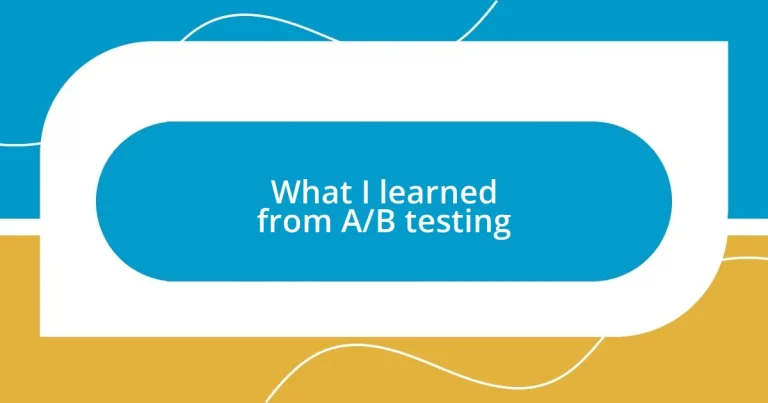Key takeaways:
- A/B testing involves comparing two versions to gather data-driven insights, guiding informed marketing decisions.
- Key aspects include controlled experiments, statistical significance, clear objectives, and embracing iterative learning.
- Common mistakes include prematurely ending tests, failing to learn from failures, and not isolating variables effectively.
- Implementing insights from A/B testing can enhance user engagement and satisfaction, fostering a culture of continuous improvement.
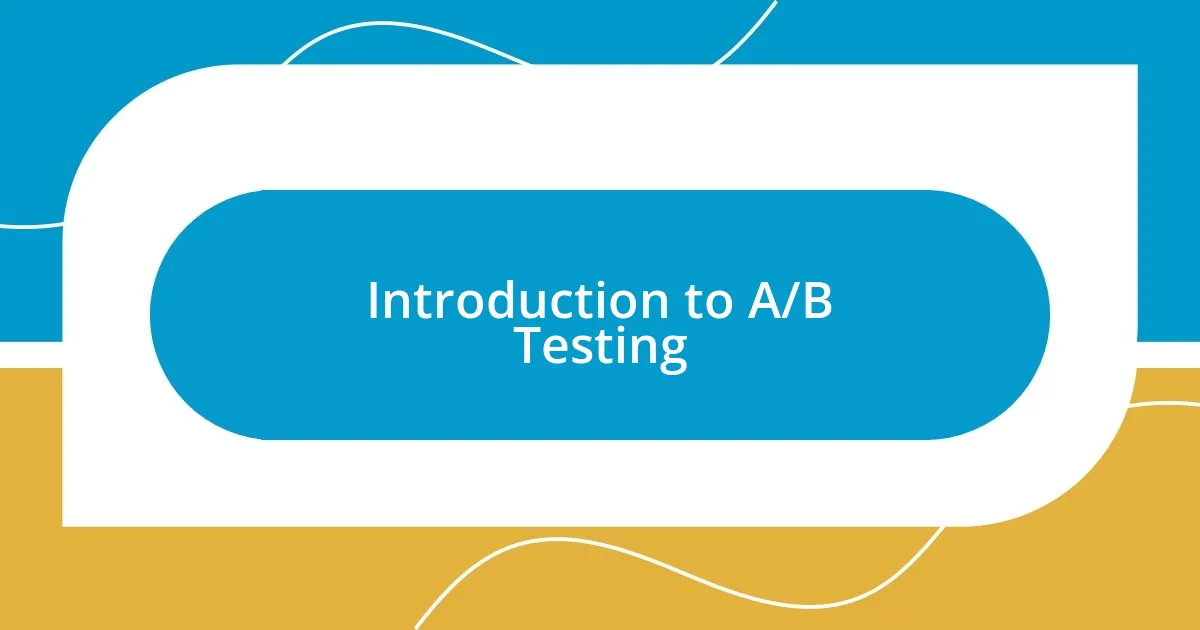
Introduction to A/B Testing
A/B testing is a powerful technique that allows you to compare two versions of a webpage, email, or ad to see which performs better. I remember the first time I ran an A/B test for a marketing campaign—I was nervous yet excited. Would the changes I made really make a difference?
By splitting my audience into two groups, I could gather real data on user behavior, which was a game-changer for my decision-making process. It felt like unlocking a door to a treasure trove of insights, where I could almost hear the audience’s preferences whispering at me. Isn’t it amazing how just a slight tweak in a call-to-action can lead to significantly higher conversion rates?
Through this iterative process, not only did I become more attuned to my audience’s needs, but I also learned to embrace failure as part of the journey. Each test, whether a success or a setback, taught me invaluable lessons about customer engagement—presenting real opportunities to refine my approach. Have you ever questioned your assumptions about what your audience wants? A/B testing can provide that clarity, guiding you toward informed decisions rooted in actual data.
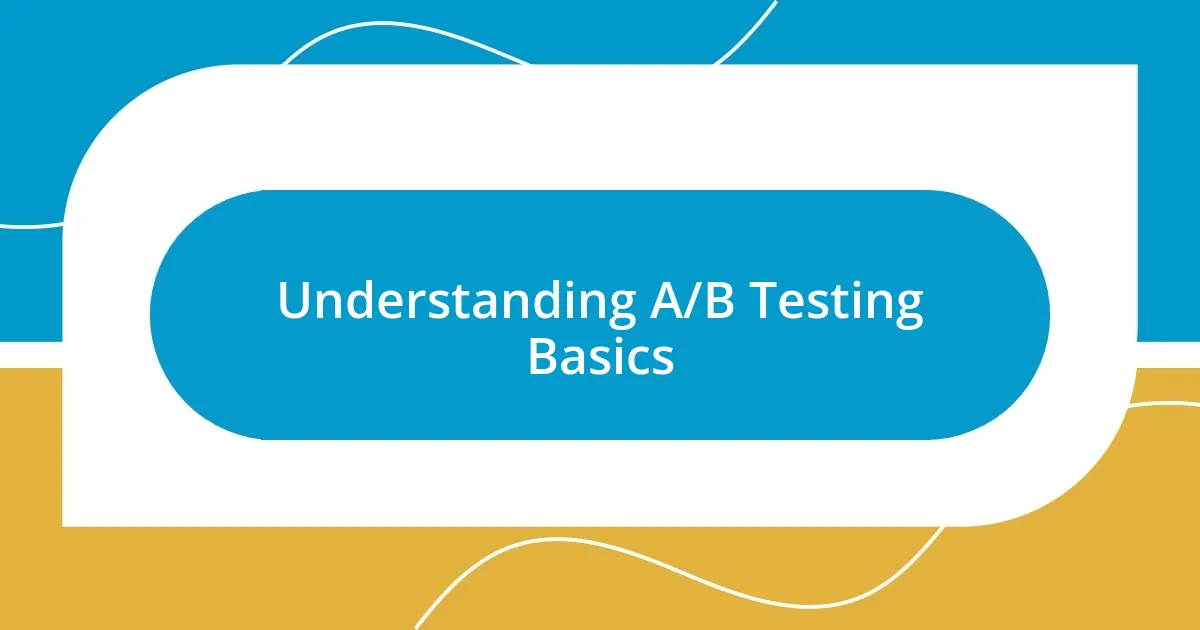
Understanding A/B Testing Basics
Understanding A/B Testing Basics
When I first delved into A/B testing, the foundational concepts intrigued me. This method isn’t just about running two versions of the same content; it’s a systematic approach to decisions guided by data. The thrill of gauging audience reactions based on real behavior was intoxicating. It’s like having a secret weapon that shows you what resonates and what falls flat.
Key aspects to consider in A/B testing include:
- Controlled experiments: Always test one variable at a time to isolate its effect.
- Statistical significance: Ensure your sample size is large enough to trust the results.
- Clear objectives: Know what you want to achieve, whether it’s higher click-through rates or increased sales.
- Iterative learning: Embrace both successes and failures; they both lead to deeper insights.
Once, during a campaign for a product launch, I debated whether a vibrant button color would attract more clicks. After testing, I found that a simple shade change tripled engagement! It was a moment of joy mixed with disbelief—proof that small details can wield significant influence.
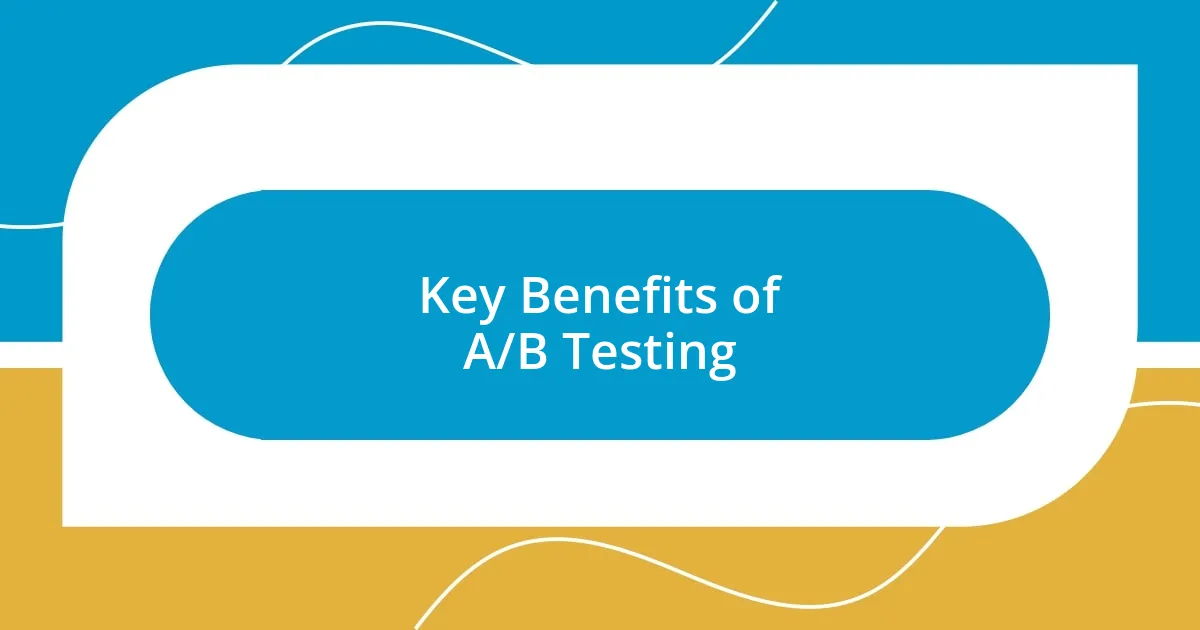
Key Benefits of A/B Testing
The beauty of A/B testing lies in its ability to deliver measurable results. I’ve noticed that data-driven insights really empower marketers like myself to make informed choices. The thrill of seeing which version triumphs feels like a mini victory that fuels my desire for continuous improvement. The focus on real user feedback creates a symbiotic relationship between testing and optimizing, leading to greater alignment with my audience’s preferences.
One major benefit I’ve experienced is a boost in conversion rates. When I tested different headlines for my email campaigns, I was stunned to discover that a more conversational approach led to a 30% increase in open rates. It reminded me how often we underestimate the power of language in shaping responses. Adjusting just a few words can lead to remarkable engagement, reinforcing that testing isn’t just a good practice; it’s essential for growth.
Another critical advantage of A/B testing is reducing guesswork and eliminating bias. I remember hesitating over a design change for a new feature on my website, wondering if it would turn users away. By A/B testing the change, I was able to see empirical evidence that supported my intuition. This objective approach not only helped me enhance user experience but also gave me the confidence to experiment more. It’s like giving yourself permission to explore; each successful test adds a layer of assurance.
| Benefit | Description |
|---|---|
| Data-Driven Insights | Empowers decisions based on actual user behavior rather than assumptions. |
| Increased Conversion Rates | Small adjustments can lead to significant improvements in engagement. |
| Reduced Guesswork | Minimizes bias and uncertainty in decision-making, fostering more confidence in changes. |
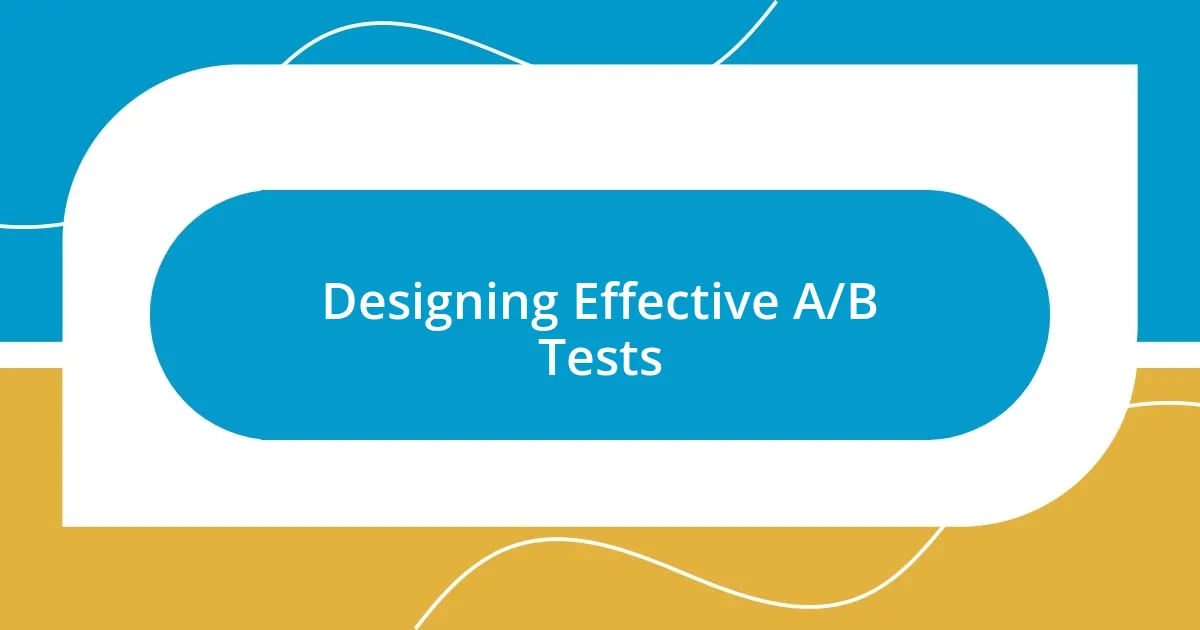
Designing Effective A/B Tests
Designing an effective A/B test starts with a clear and focused hypothesis. I remember crafting a hypothesis once about changing the layout of my landing page to improve user engagement. Instead of making multiple changes at once, I pinpointed just the header format. This approach allowed me to confidently assess the impact without the noise of other variables influencing the results.
It’s crucial to select the right metrics to measure success. I’ve learned that choosing the wrong metric can lead to misleading conclusions. For instance, when I initially focused solely on page views, I missed out on the bigger picture of user engagement. Eventually, I shifted my attention to metrics like time spent on the page and conversion rates, which provided a clearer understanding of how users interacted with the content.
Finally, timing plays a vital role in the validity of your A/B tests. I often think about a campaign I launched just before a major holiday. Although I was eager to see quick results, I quickly learned that people’s behaviors can shift dramatically during these periods. Running tests when users are likely distracted can skew outcomes. So my advice is to always take calendar context into account before hitting that start button. How about you? Have you ever considered how external factors might influence your test results?
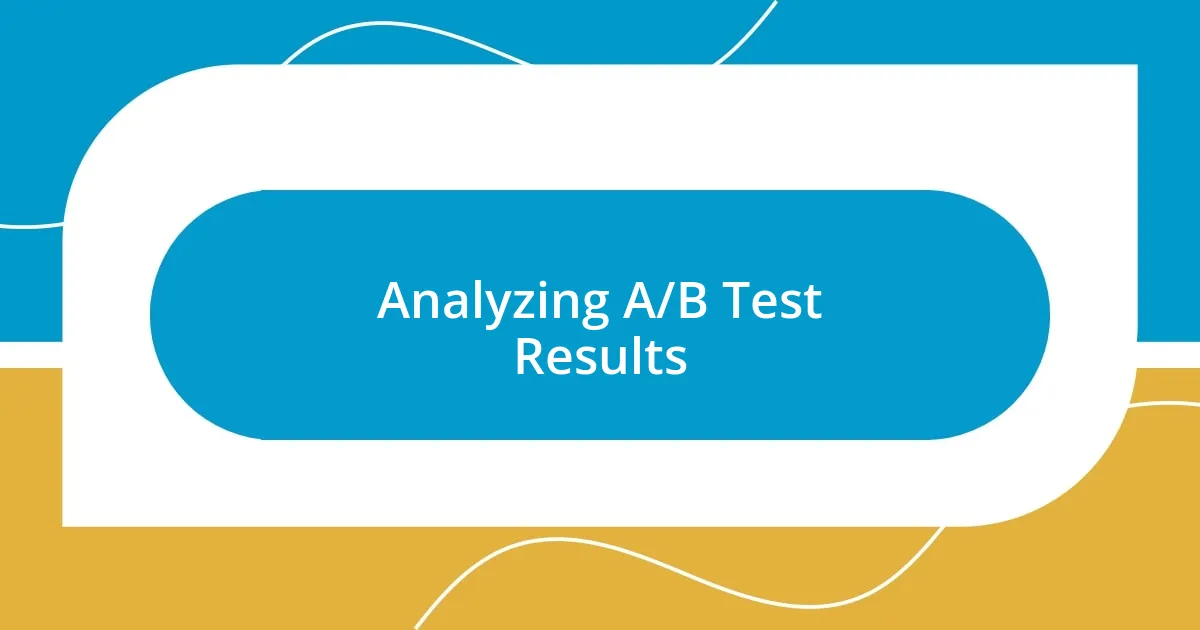
Analyzing A/B Test Results
Analyzing A/B test results can feel like unwrapping a gift filled with insights. I recall one instance where I ran an email campaign to test subject lines, and the analysis revealed not only which one performed better but also why. Diving into the data showed me that the winning subject line sparked curiosity and even reflected the language my audience was using. This taught me that understanding the underlying emotions behind metrics is just as important as the numbers themselves.
As I sifted through the results, I learned the importance of statistical significance. Early on, I often felt discouraged if one version didn’t seem overwhelmingly better than the other. In one case, a variant that only marginally outperformed another taught me about the concept of significance levels. Realizing that small improvements can lead to substantial impacts over time really shifted my mindset. Have you ever dismissed a result because it didn’t meet your expectations? I’ve been there, too, but now I understand that even slight advantages can accumulate into big wins.
Emphasizing the power of storytelling is crucial in this phase. I remember a test where the layout of my product page was scrutinized. The numbers indicated a change, yet the story behind user feedback painted a richer picture. Users expressed confusion over certain design elements, which clarified why the data shifted. It felt like connecting the dots between emotion and logic – what’s more essential than listening to your audience? The anecdotes they shared helped me not only optimize the design but also deepen my connection with them. Isn’t it fascinating how a deeper analysis of A/B tests transforms simple numbers into compelling narratives?
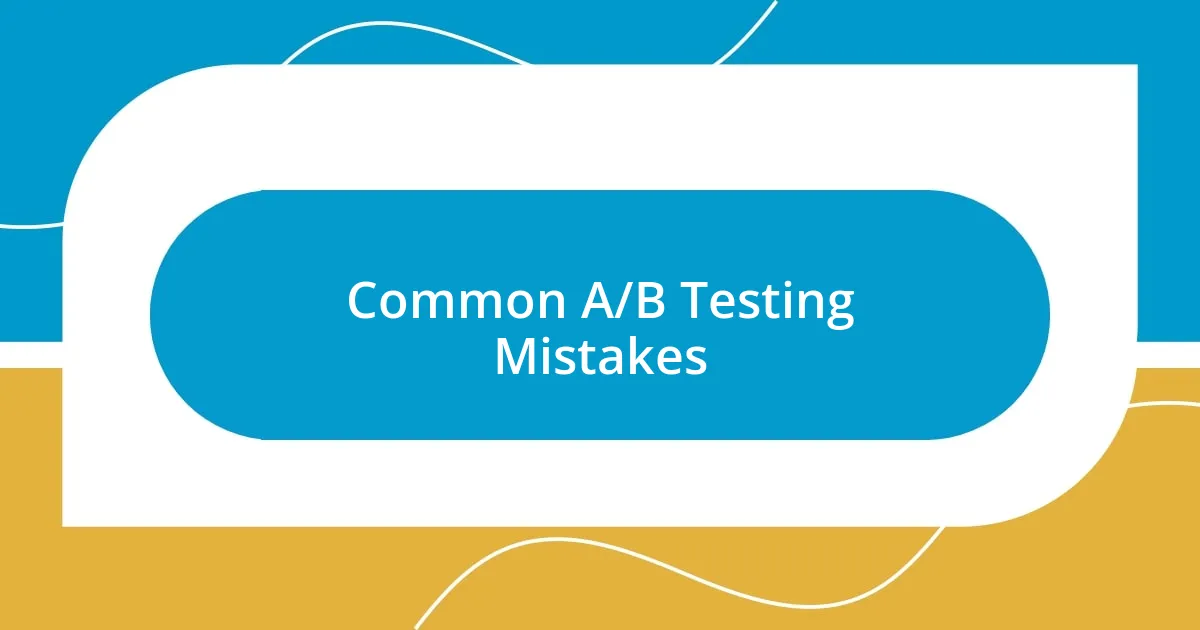
Common A/B Testing Mistakes
One of the most common mistakes I see people make in A/B testing is failing to run tests long enough. I vividly remember launching an A/B test on a new button color for a call-to-action. I was so eager to see results that I stopped the test prematurely after a couple of days. It turned out that the fluctuations I observed were just typical daily variations and not genuine trends. Have you ever felt the rush to make a decision, only to realize later that timing is everything? Patience is key in this game.
Another blunder occurs when teams don’t embrace a culture of learning from failures. There was a time when I chalked up a failed test to a “bad idea” and moved on, but I later realized I missed a goldmine of insights. Each test, whether it leads to success or failure, can teach you something valuable about your audience and their preferences. Have you ever overlooked an opportunity simply because it didn’t go as planned? Shifting my perspective helped me appreciate every outcome.
Lastly, I can’t stress enough the importance of isolating variables. I once attempted to test different headlines, images, and layouts simultaneously on a webpage. It was chaos! The results were inconclusive and frustrating because I had no idea which element influenced user behavior. When you think about it, isn’t it more rewarding to pinpoint exactly what works or doesn’t? Through that experience, I learned to change one aspect at a time, allowing me to hone in on what truly resonates with my audience.
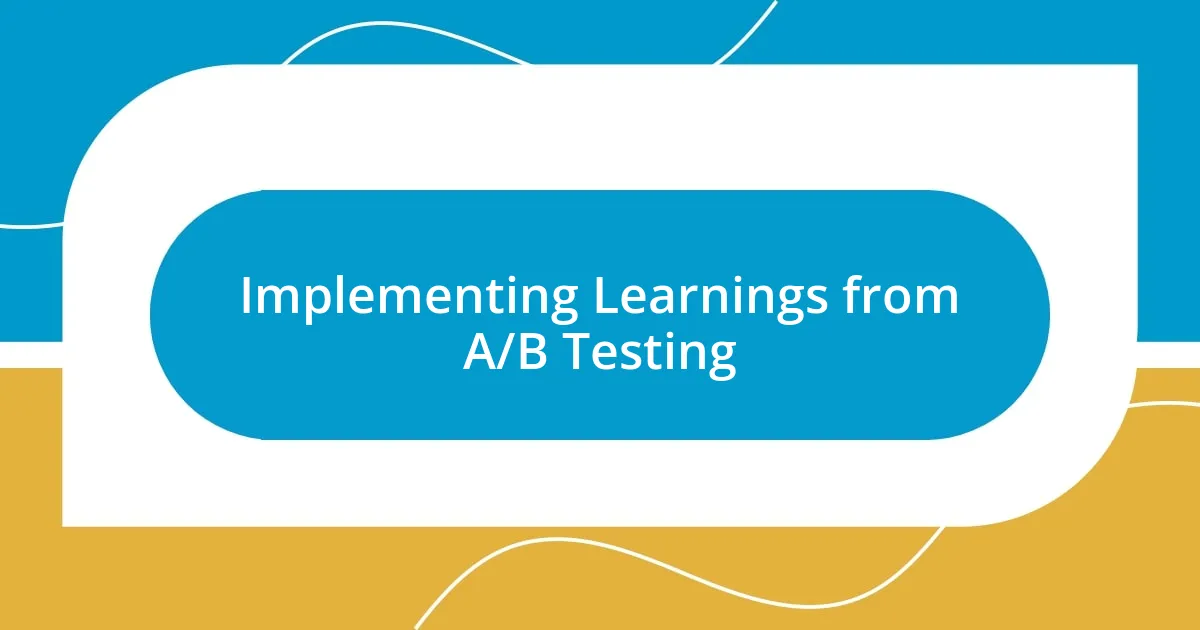
Implementing Learnings from A/B Testing
Implementing the insights gained from A/B testing can be a game-changer for your projects. I remember a time when I applied the findings from a test about my website’s navigation structure. After identifying which layout led to longer user engagement, I rolled out the changes swiftly. The result? My website not only saw increased page views but also a noticeable uptick in user satisfaction. It became immediately clear to me that acting on what you learn can amplify results significantly.
One strategy I particularly value is creating a feedback loop based on your findings. Following a test where different product descriptions were pitted against one another, I took the winning descriptions and integrated them into my future campaigns. This not only allowed me to enhance the messaging but also opened avenues for additional tests on even more nuanced aspects like tone and style. Have you ever tried to build on success? It’s like stacking blocks, each one supporting the next, creating something much bigger than just the initial test.
Perhaps most importantly, I learned to embrace an iterative approach. After observing the success of a small change, instead of declaring victory, I continued to tweak and optimize. For instance, after discovering that a simple call-to-action button color increased conversions, I experimented with size and placement next. The habit of seeking continuous improvement not only kept the momentum going but also fostered a culture of experimentation within my team. Isn’t it liberating to know that each test you implement fuels your understanding and drives better outcomes?












